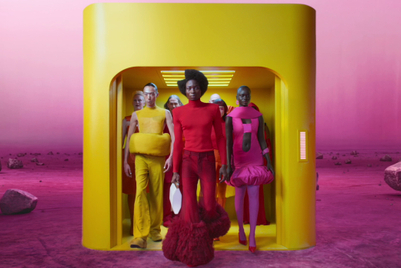.png&h=570&w=855&q=100&v=20170226&c=1)
Jaguar’s 30-second rebranding film, which left millions puzzled, has been defended by its boss. With 165 million views on X, it has generated some of the most negative brand vitriol in recent years.
Elon Musk’s succinct reaction, “Do you sell cars?” perfectly captured the widespread confusion and derision. Another query asked, “Is this supposed to rescue your tarnished image?” One plaintive comment simply featured an image of an E-Type in British racing green with the words “what you once were” underneath it. Even by the standards of Bud Light or Gillette, the latest Jaguar commercial is turning out to be a PR disaster of epic proportions.
Given the spate of negative media headlines about the company alienating and abandoning everything that defined it—its logo, British heritage, traditional fuel-powered cars, market positioning, pricing strategy, and even its loyal consumer base—the company’s attempts at playful responses to criticism might only amplify the cringe factor. Auto journalists attending the launch event weren’t impressed either, with one describing it as a “drunken dream” and a “cult-like experience.”
Around 800 people are reported to have worked on the rebrand, which will culminate with the unveiling of a ‘design vision concept’ at Miami Art Week on December 2.
Sunitha Natarajan, director of digital strategy at Social Panga, discusses the spate of harsh reviews, and adds, “The confusion was expected, given Jag’s consistent image since the 60s. However, this very familiarity also necessitated a drastic change. The company has big goals for EVs in the future, and this transformation showcases its commitment to innovation. The timing is perfect to redefine Jaguar’s legacy. We’ve only seen the beginning; the full picture of Jaguar’s efforts is yet to unfold.”
Meanwhile, Rawdon Glover, managing director of the Indian-owned firm, defended the rebranding as a necessary departure from “traditional automotive stereotypes,” arguing that playing it safe would lead to being “drowned out.” In an interview with the Financial Times, Glover said the intended message had been lost in “a blaze of intolerance” on social media and denied that the promotional video was intended as a “woke” statement.

“If we play in the same way that everybody else does, we’ll just get drowned out. So we shouldn’t turn up like an auto brand,” Glover said. “We need to re-establish our brand, and at a completely different price point, so we need to act differently. We wanted to move away from traditional automotive stereotypes.”
Glover reiterated that while the overall buzz of the new campaign had been “very positive,” he was disappointed by “the level of vile hatred and intolerance” in the comments regarding the individuals who appeared in the video.
However, this explanation fails to address the fundamental concerns of those who see the rebrand as a betrayal of the brand’s heritage and a misguided attempt at relevance.
Analysis by research analytics firm Carma reveals a dramatic drop in online sentiment for the British luxury car automaker. “Before the rebranding, conversations about Jaguar were 23.1% positive and 21% negative. After the campaign launch, those figures plummeted to 15.3% positive and a shocking 40.5% negative.”

"This significant drop reflects the widespread disappointment and outrage expressed online. The comments section of the video is also a battleground of opinions, ranging from simple confusion (‘Do you sell cars?’) to nostalgic laments for Jaguar’s iconic past. The company’s attempts at damage control only seemed to pour fuel on the fire, leaving many feeling alienated and unheard,” said Carma while sharing its analysis with Campaign Asia-Pacific.
Ramakrishnan Raja, a marketing transformation consultant at Resonant, offered a scathing critique of the rebranding efforts. “These numbers by Carma don’t just indicate dissatisfaction—they signal a collapse in consumer goodwill. Loyalty is hard-earned and easily lost,” Raja explained. “Rebranding isn’t rocket science; it’s a delicate but well-trodden process. The fundamental error isn’t in Jaguar’s desire to evolve—it’s in its shocking willingness to alienate its core audiences to chase a seemingly androgynous, undefined new one.”
Raja did not mince words when addressing Jaguar’s betrayal of its legacy. “Jaguar’s heritage—elegance, performance, and Britishness—has been unceremoniously tossed aside for a colourised glimpse of a rock. A ROCK! The campaign’s disconnect from both automotive desires and brand heritage is not just disappointing—it’s a callous misreading of today’s cultural and market realities.”
Jaguar’s “social media tease” this week, ahead of its relaunch as an electric-only brand in early December, has been evaluated by creative and PR experts. Perhaps, Jaguar’s strategy is that shock is the new effective. While the rebranding emphasises “copy nothing,” the commercial closely resembles Apple’s iconic 1984 Super Bowl spot (watch below). Both aimed for shock value to cut through the noise.
However, unlike Apple, which had a revolutionary product to justify its bold message, Jaguar's rebrand lacks a tangible product launch to support the disruption. The new electric vehicles are slated for release in 2026, still two years away, leaving the current campaign adrift in a sea of negative publicity.

Online commentary also draws parallels with Bud Light's marketing debacle. Both brands, steeped in heritage, attempted to appeal to a younger, more diverse audience with a radical rebranding, only to face massive backlash and plummeting sales for the former.
Jaguar’s shift towards a “design-minded” and “cash-rich, time-poor” demographic risks alienating its existing customer base. The company’s strategy is a high-stakes gamble: it plans to retain only 10-15% of its current customers while sharply increasing prices.
This move is especially risky, given the mounting negative sentiment. However, despite the confusion and backlash, it's achieving its goal: getting people to think and talk about Jaguar again.


.png&h=334&w=500&q=100&v=20170226&c=1)

.png&h=334&w=500&q=100&v=20170226&c=1)
.png&h=334&w=500&q=100&v=20170226&c=1)
.jpg&h=334&w=500&q=100&v=20170226&c=1)


.jpg&h=334&w=500&q=100&v=20170226&c=1)
.png&h=334&w=500&q=100&v=20170226&c=1)
.jpg&h=334&w=500&q=100&v=20170226&c=1)
.jpg&h=268&w=401&q=100&v=20170226&c=1)

.jpg&h=268&w=401&q=100&v=20170226&c=1)
.jpg&h=268&w=401&q=100&v=20170226&c=1)


.png&h=268&w=401&q=100&v=20170226&c=1)
.jpg&h=268&w=401&q=100&v=20170226&c=1)